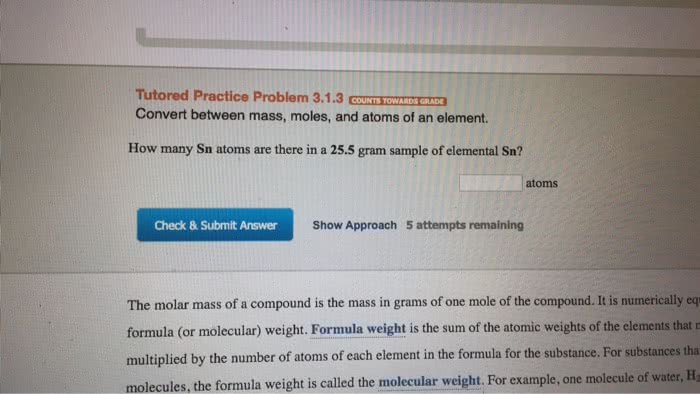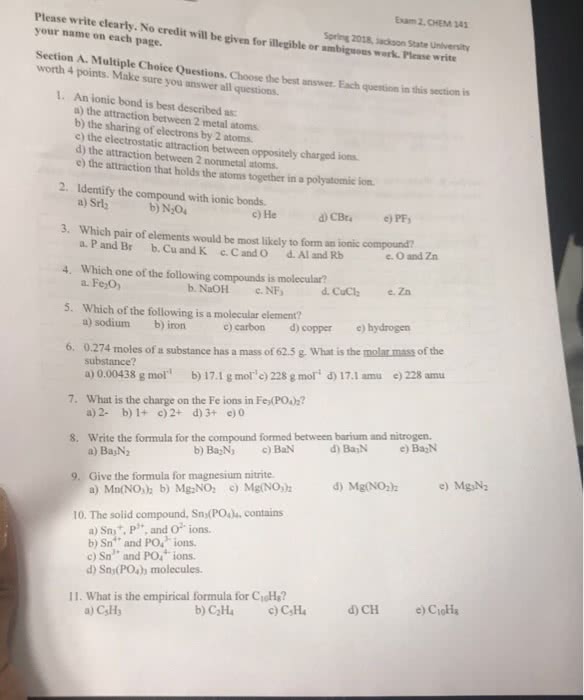CHEM 1150 Lecture Notes - Molar Mass, Carbon-12, Unified Atomic Mass Unit

Mole (mol): amt. of a substance that contains the same # of entities as there are
atoms in exactly 12g of carbon-12 (Avogadro's #)
Mass of one mole of atoms= molar mass
Molar mass of an element, in g's, is numerically = to element's
atomic mass in amu
§
Lighter the atom, less of a mole of that atom weighs
Lighter the atom, more atoms there are in that 1 g
□
§
○
Mole hill conversions
§
○
-
What about molecules and compounds? Use this to calculate molar mass in
g/mol
Ex. Ammonium Sulfate
(NH4)2SO4
2 N's= 2*14.01g/mol=28.02g/mol
®
8 H's 8*1.008g/mol=8.064g/mol
®
1 S =32.06g/mol
®
4 O's 4*16.00g/mol=64g/mol
®
Add them add up: 132g/mol (look at least # of decimal
places for SDs)
®
□
§
○
-
**WILL SOMETIMES GIVE US MOLECULAR WEIGHT AS FW (FORMULA
WIEGHT)**
-
If ask for formula units want atoms/ molecules**
For every mol of NH4)2CO3= 2 mol N□
§
○
-
Mole hill
-
Mass % of element X= moles of X in formula * (molar mass of X g/mol) / (Molar
Mas in g of 1 mol of compound) * 100
Remember Law of Definite Proportions
○
Ex. MW of glucose (C6H12O6)= 180.16 g/mol
Mass % of C in glucose?
6 mol C * 12.01 g/mol C= 72.06 g C/ 180.16 g glucose * 100=
40.00% C
This is a conversion factor!
®
□
§
○
-
Empirical formula: simplest formula agrees w/ the elemental analysis and gives
rise to the smallest set of whole numbers of atoms
-
Molecular formula: tells you how many atoms of each element are in a
compound
Ex. 2.82g of Na, 4.35g of Cl, and 7.83 g of O. Find empirical formula and it's
name
Steps:
Number of moles of each element□
Divide each by lowest mol amt. to find mol ratios (empirical
formula)
□
§
○
What if not whole #s?
Start by multiplying subscripts by 2 and typically won't have to go
past 5 (3, 4, etc.)
§
○
Determine molecular formula given molecular weight and mass
percentages
Ex. Lactic acid (M= 90.08 g/mol), 40.0% C, 6.71% H, and 53.3% O
First determine empirical formula
3.33 mol C, 6.66 mol H, 3.33 mol O
Divide each by 3.33
CH2O
}
◊
®
□
Determine molecular formula
Once determine relative moles of each element, divide
by lowest mol amount to find relative mol ratios
(empirical formula)
Molar mass of lactic acid/ molar mass of empirical
◊
formula= 90.08g/ 30.03g= 3
Multiply empirical formula by 3=C3H6O3
}
◊
®
□
§
○
-
Chapter 3
Wednesday, January 24, 2018
11:42 AM
Document Summary
Mole (mol): amt. of a substance that contains the same # of entities as there are atoms in exactly 12g of carbon-12 (avogadro"s #) Mass of one mole of atoms= molar mass. Molar mass of an element, in g"s, is numerically = to element"s atomic mass in amu. Lighter the atom, less of a mole of that atom weighs. Lighter the atom, more atoms there are in that 1 g. Use this to calculate molar mass in g/mol. Add them add up: 132g/mol (look at least # of decimal places for sds) **will sometimes give us molecular weight as fw (formula. If ask for formula units want atoms/ molecules** For every mol of nh4)2co3= 2 mol n. For every mol of nh ) co = 2 mol n. Mass % of element x= moles of x in formula * (molar mass of x g/mol) / (molar. Mas in g of 1 mol of compound) * 100.





